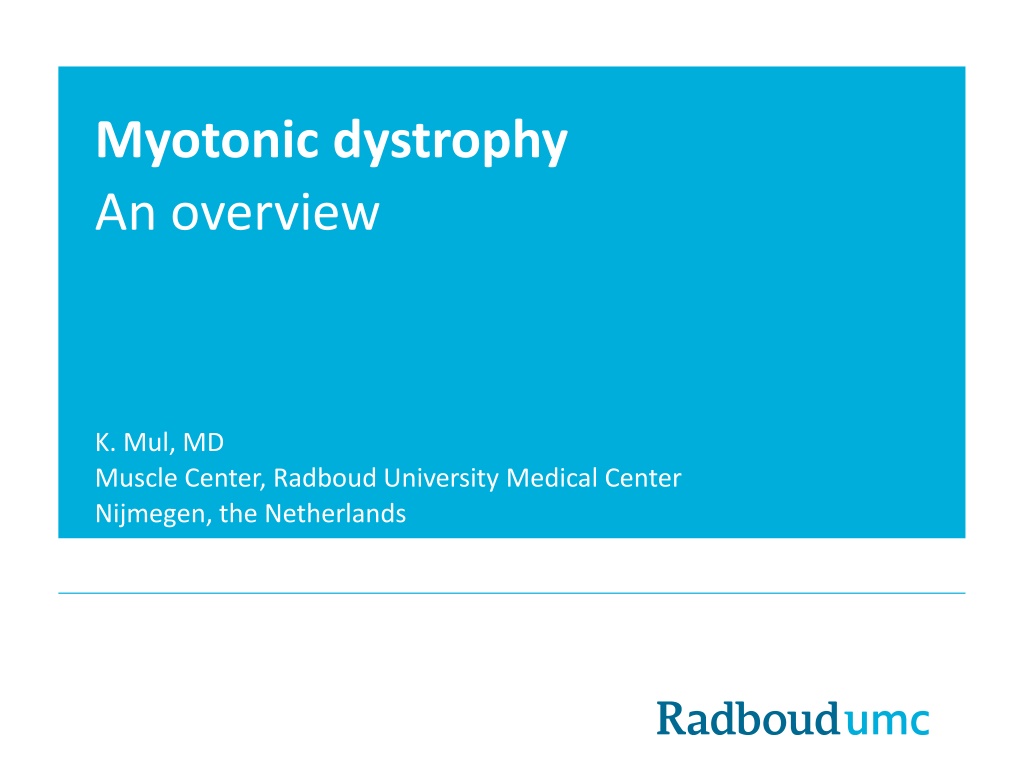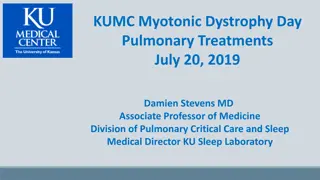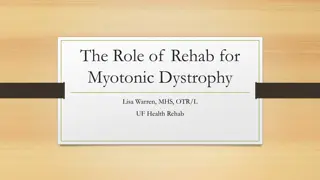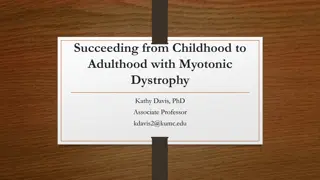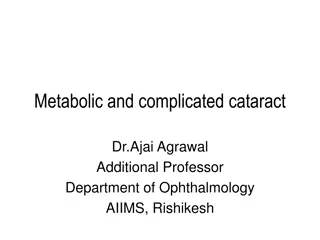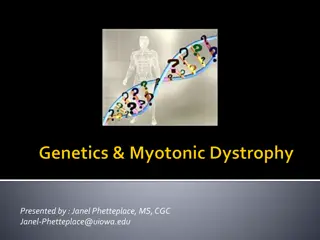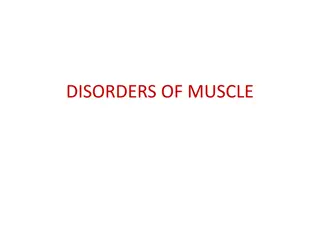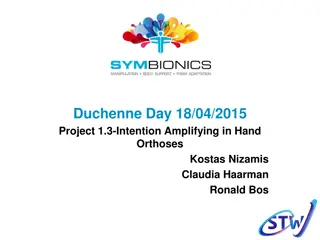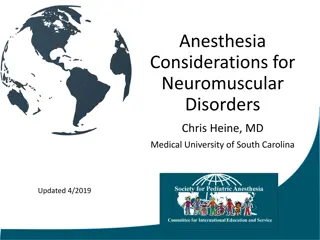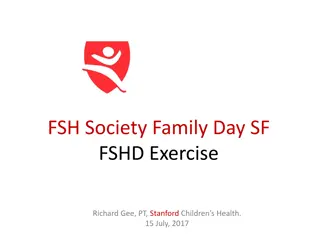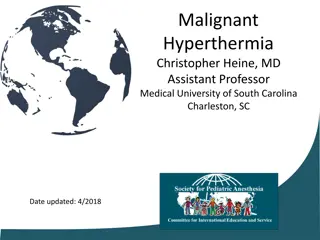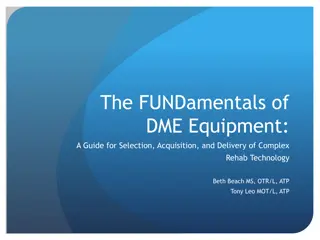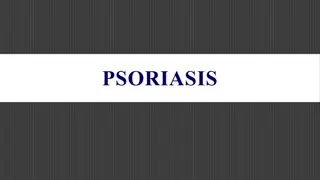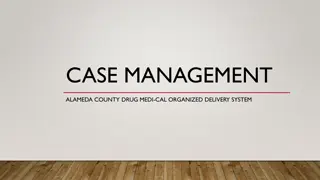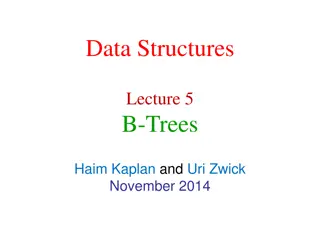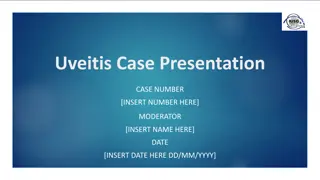Understanding Myotonic Dystrophy: A Comprehensive Overview
Myotonic dystrophy is a multisystem genetic disorder that can affect individuals at different stages of life, from infants to adults. It presents with various symptoms such as muscle weakness, myotonia, cognitive and behavioral issues, respiratory problems, and more. The disease progression and manifestations can vary, impacting different organ systems including the heart, eyes, gastrointestinal tract, endocrine system, and central nervous system. Early diagnosis and proper management are crucial in addressing the complexities of this condition.
Download Presentation

Please find below an Image/Link to download the presentation.
The content on the website is provided AS IS for your information and personal use only. It may not be sold, licensed, or shared on other websites without obtaining consent from the author. Download presentation by click this link. If you encounter any issues during the download, it is possible that the publisher has removed the file from their server.
E N D
Presentation Transcript
Myotonic dystrophy An overview K. Mul, MD Muscle Center, Radboud University Medical Center Nijmegen, the Netherlands
Myotonic dystrophy type 1 Multisystem disorder Can affect babies, children, or adults Genetic disease that is passed on from parent to child Can get worse in subsequent generations (anticipation)
Childhood Congenital 1-12 jaar Neonaten Leer en spraakproblemen Bulbaire spierzwakte, variabel Minderheid heeft vertraagde motorische ontwikkeling Sporadisch ritmestoornissen IQ 70-100 > 50-70 Moeheid Aandachtstoornis, hyperactiviteit Mediane overleving cf. adulte type Hypotonie en contracturen Respiratoire en slikproblemen IQ 40-70 Mediane overleving 4e decade Classical / adult-onset Mild / late-onset 50 jaar en ouder Cataract 12-50 jaar Myotonie Spierzwakte in gelaat en distale extremiteiten Rolstoelafhankelijkheid in 50% Multi-orgaan betrokkenheid Cognitieve en gedragsstoornissen - apathie Moeheid Mediane overleving 60e jaar Acute hartdood 20-30% van overlijden Lichte spierzwakte, variabele myotonie Zeer beperkte progressie spierbetrokkenheid hyperactiviteit Mediane overleving cf. adulte type
Classical (adult-onset) DM1 Multisystem disorder Clinical hallmarks: muscle weakness and myotonia
Classical (adult-onset) DM1 Muscle weakness Facial weakness is common Difficulty lifting head from pillow Weakness in limbs, usually distal Finger flexors Ankle dorsiflexors causing foot drop Weakness of the diaphragm Later in disease course more proximal weakness
DM1 is a multisystem disorder Heart Eyes Gastro-intestinal Endocrine Sleep Central nervous system
Childhood Congenital 1-12 jaar Neonaten Leer en spraakproblemen Bulbaire spierzwakte, variabel Minderheid heeft vertraagde motorische ontwikkeling Sporadisch ritmestoornissen IQ 70-100 > 50-70 Moeheid Aandachtstoornis, hyperactiviteit Mediane overleving cf. adulte type Hypotonie en contracturen Respiratoire en slikproblemen IQ 40-70 Mediane overleving 4e decade Classical / adult-onset Mild / late-onset 50 jaar en ouder Cataract 12-50 jaar Myotonie Spierzwakte in gelaat en distale extremiteiten Rolstoelafhankelijkheid in 50% Multi-orgaan betrokkenheid Cognitieve en gedragsstoornissen - apathie Moeheid Mediane overleving 60e jaar Acute hartdood 20-30% van overlijden Lichte spierzwakte, variabele myotonie Zeer beperkte progressie spierbetrokkenheid hyperactiviteit Mediane overleving cf. adulte type
Congenital DM1 Severe, can present potentially life-threatening issues at birth 99% of cases is passed on from mother to child Before birth: an excess of amniotic fluid and reduced fetal movements After delivery: severe generalized weakness and hypotonia (floppy baby), respiratory problems
Congenital DM1 Characteristic tented upper lip making suckling difficult
Congenital DM1 High mortality rate in baby s due to respiratory failure Common problems: feeding difficulties, failure to thrive, club feet Surviving children: gradual improvement in motor function and respiratory function, become able to walk Learning difficulties Early adulthood: symptoms as in the classical form of DM1 can develop Often severe problems of the cardiorespiratory system in third and fourth decade
Childhood Congenital 1-12 jaar Neonaten Leer en spraakproblemen Bulbaire spierzwakte, variabel Minderheid heeft vertraagde motorische ontwikkeling Sporadisch ritmestoornissen IQ 70-100 > 50-70 Moeheid Aandachtstoornis, hyperactiviteit Mediane overleving cf. adulte type Hypotonie en contracturen Respiratoire en slikproblemen IQ 40-70 Mediane overleving 4e decade Classical / adult-onset Mild / late-onset 50 jaar en ouder Cataract 12-50 jaar Myotonie Spierzwakte in gelaat en distale extremiteiten Rolstoelafhankelijkheid in 50% Multi-orgaan betrokkenheid Cognitieve en gedragsstoornissen - apathie Moeheid Mediane overleving 60e jaar Acute hartdood 20-30% van overlijden Lichte spierzwakte, variabele myotonie Zeer beperkte progressie spierbetrokkenheid hyperactiviteit Mediane overleving cf. adulte type
Childhood-onset DM1 Typically first presents with learning difficulties Myotonia often develops at an older age Facial weakness Can be passed on both by father or by mother
Childhood Congenital 1-12 jaar Neonaten Leer en spraakproblemen Bulbaire spierzwakte, variabel Minderheid heeft vertraagde motorische ontwikkeling Sporadisch ritmestoornissen IQ 70-100 > 50-70 Moeheid Aandachtstoornis, hyperactiviteit Mediane overleving cf. adulte type Hypotonie en contracturen Respiratoire en slikproblemen IQ 40-70 Mediane overleving 4e decade Classical / adult-onset Mild / late-onset 50 jaar en ouder Cataract 12-50 jaar Myotonie Spierzwakte in gelaat en distale extremiteiten Rolstoelafhankelijkheid in 50% Multi-orgaan betrokkenheid Cognitieve en gedragsstoornissen - apathie Moeheid Mediane overleving 60e jaar Acute hartdood 20-30% van overlijden Lichte spierzwakte, variabele myotonie Zeer beperkte progressie spierbetrokkenheid hyperactiviteit Mediane overleving cf. adulte type
Mild form Very mild symptoms: cataract, myotonia, minor weakness Starting at later age: 5th to 7th decade Often do not seek medical attention
Genetic mechanism for DM1 Diverse clinical manifestation, same genetic mechanism
DNA contains the construction code for our bodies Blood cell Muscle cell Nerve cell DNA is packed into 46 chromosomes per cell 19
DNA contains the code to construct proteins, the body s building blocks
Myotonic dystrophy 1: abnormal CTG- series Expanded CTG-series DNA 46 chromosomes per cell chromosome nr. 19 23
GGATCCGCCAAGGACTTTGATTATTGCGTGAAAGTGCTGACTGCCA GGACAGGAAGCTAGCTAAGATGCAAGTTCCCAGCCTAGAGCAGTGG CCTCTGGCTGCTGCTGCTGCTGCTGCTGCTGGGGGTCTAGGGCGG ACCCAAGGGCAAGGCCAGGGTGGCAGCAGCTTGGGGACTCTGGC TGGCTCCCTCCCCTGACACTGGCTGAAGCCCAGGTGGTCTCTAACC CCTCCCATCTCTCCCTCTCATCTTCCCCAGGGCATCTCCTCCCAACC AGGCAACTCCCCGAGTGGCACAGTGGTGTGAAGCCATGGATATCGG GCCCCCCCAACCCCATGCCCCCAGCCTCCTAGCCATAACCCTCCCT GCTGACCTCACAGATCAACGTATTAACAAGACTAACCATGATGGATG GACTGCTCCAGTCCCCCCACCTGCACAAAATTTGGGGGCCCCCCA GACTGGCCCGGACACGGGCGATGTAATAGCCCTTGTGGCCTCAGC CTTGTCCCCCACCCACTGCCAAGTACAATGACCTCTTCCTCTGAAAC ATCAGTGTTACCCTCATCCCTGTCCCCAGCATGTGACTGGTCACTCC TGGGGAGACACTCCCCGCCCCTGCCACAAGAGCCCCAGGTCTGCA GTGTGCCCCTCAGTTGAGTGGGCAGGGCCGGGGGTGGTCCAGCC CTCGCCCGGCCCCCACCCCAGCTGCCCTTGCTATTGTCTGTGCTTT TGAAGAGTGTTAAATTATGGAAGCCCCTCAGGTTCCTCCCTGTCCCG CAGGACCTCTTATTTATACTAAAGTTCCCTGTTTTCTCAGCGGGTCTG TCCCCTTCGGAGGAGATGATGTAGAGGACCTGTGTGTGTACTCTGT GGTTCTAGGCAGTCCGCTTTCCCCAGAGGAGGAGTGCAGGCCTGC TCCCAGCCCAGCGCCTCCCACCCCTTTTCATAGCAGGA
GGATCCGCCAAGGACTTTGATTATTGCGTGAAAGTGCTGACTGCCA GGACAGGAAGCTAGCTAAGATGCAAGTTCCCAGCCTAGAGCAGTGG CCTCTGGCTGCTGCTGCTGCTGCTGCTGCTGCTGCTGCTGCTGCT GCTGCTGCTGCTGCTGCTGCTGCTGCTGCTGCTGCTGCTGCTGCT GCTGCTGCTGCTGCTGCTGCTGCTGCTGCTGCTGCTGCTGCTGCT GCTGCTGCTGCTGCTGCTGCTGCTGCTGCTGCTGCTGCTGCTGCT GCTGCTGCTGCTGCTGCTGCTGCTGCTGCTGCTGCTGCTGCTGCT GCTGCTGCTGCTGCTGCTGCTGCTGCTGCTGCTGCTGCTGCTGCT GCTGCTGCTGCTGCTGCTGCTGCTGCTGCTGCTGCTGCTGCTGCT GCTGCTGCTGCTGCTGCTGCTGCTGCTGCTGCTGCTGCTGCTGCT GCTGCTGCTGCTGCTGCTGCTGCTGCTGCTGCTGCTGCTGCTGCT GCTGCTGCTGCTGCTGCTGCTGCTGCTGCTGCTGCTGCTGCTGCT GCTGCTGCTGCTGCTGCTGCTGCTGCTGCTGCTGCTGCTGCTGCT GCTGCTGCTGCTGCTGCTGCTGCTGCTGCTGCTGCTGCTGCTGCT GCTGCTGCTGCTGCTGCTGCTGCTGCTGCTGCTGCTGCTGCTGCT GCTGCTGCTGCTGCTGCTGCTGCTGCTGCTGCTGCTGCTGCTGCT GCTGCTGCTGCTGCTGCTGCTGCTGCTGCTGCTGCTGCTGCTGCT GCTGCTGCTGCTGCTGCTGCTGCTGCTGCTGCTGCTGCTGCTGCT GCTGCTGCTGCTGCTGCTGCTGCTGCTGCTGCTGCTGCTGCTGCT GCTGCTGCTGCTGCTGCTGCTGCTGCTGCTGCTGCTGCTGCTGCT GCTGCTGCTGCTGCTGCTGCTGCTGCTGCTGGGGGTCTAGGGCGG
Variability in length of CTG repeats CTG-length increases: 50 up to over 3000 repeats 5 - 37 #19 = CTGCTGCTGCTGCTGCTGCTGCTG 26
The expanded CTG-serie damages cells Abnormal gene (DNA) Toxic copy (RNA) Toxic RNA affects cellular processes Damage to different types of cells Loss of organ function
Normal sized CTG-series (healthy) Proteins that stick on repeat RNA repeat RNA Slide courtesy of Charles Thornton, MD, University of Rochester Medical Center
Expanded CTG-series (DM1) More proteins can stick on repeat RNA Slide courtesy of Charles Thornton, MD, University of Rochester Medical Center
Slide courtesy of Charles Thornton, MD, University of Rochester Medical Center
Expanded sticky RNA does damage to the cells Other proteins sticking to the RNA are needed by the cell The cell produces the wrong versions of proteins that don t work right Some are in your muscle and cause myotonia and weakness Some are in your heart Some are in your eyes
Relation between disease severity and CTG repeat length IV 1000 III 500 II 100 I 40 I II III IV = Mild = Adult-onset = Childhood-onset = Congenital (CTG)n 80 1000 2000 5000 N.B. Large variability between patients
CTG-repeat is unstable Differents in different tissues (blood, muscle, heart, etc) Changes over time Changes when passed on to a child
Anticipation The disease symptoms tend to be more severe and occur earlier in successive generations
Increased CTG-length when passed on from a parent to a child overgrootouder Great-grandparent 50 grootouder Grandparent 100 ouder Parent 400 kind Child 1500 35
Increased CTG-length when passed on from a parent to a child overgrootouder Great-grandparent 50 Cataract grootouder Grandparent 100 ouder Parent Adult onset 400 kind Child 1500 Congenital 36
Summary Multisystem disorder Clinical hallmarks are muscle weakness and myotonia Four different types Caused by a mutation on chromosome 19 CTG expansion Anticipation
